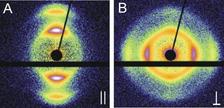MiScatter diagrams, originating from micro-X-ray experiments. A) Parallel orientation to the flow direction prior to the narrowing B) Perpendicular orientation to the flow direction after narrowing in the capillary. (Images: Department of Physical Chemistry I, University of Bayreuth croscope view of MITF crystals.)
When small particles flow through thin capillaries, they display an unusual orientation behaviour. This has been discovered by a research team led by Prof. Stephan Förster and Prof. Walter Zimmermann (University of Bayreuth, Germany) at the X-ray sources DORIS III and PETRA III of the research centre DESY in Hamburg, Germany. The discovery is of major importance for spinning processes designed for the production of synthetic fibres, and for the understanding of vascular stenosis. The scientists of Bayreuth University, the Radboud University Nijmegen (Netherlands), the Max Planck Institute for Dynamics and Self-Organization in Göttingen (Germany), and DESY report their surprising findings in the scientific journal PNAS.
Rod- or plate-like particles flowing through thin capillaries, usually orientate themselves parallel in relation to the flow direction. Should a capillary display a constriction, this alignment does not change until the particles have reached the narrowest location. As soon as the capillary expands again however, the particles align themselves perpendicular to the flow direction, having changed angle. Not only have scientists discovered this surprising phenomenon, they have also found an explanation. In theoretical calculations they were able to show that within the dilating capillary segment, strong dilating forces appear perpendicular to the flow direction. Such dilating effects a realignment of the particles.
The theoretical calculations were confirmed using micro X-ray experiments at Deutsches Elektronen-Synchrotron DESY. Using the light source PETRA III, highly intensive X-rays were produced measuring merely ten micrometers in diameter. With the help of this narrowly focussed beam it was possible for the first time to observe the streaming behaviour in particularly thin capillaries. The scientists were able to precisely determine the alignment of particles flowing through a constricted capillary. The perpendicular orientation which is taken on after passing the narrowest point remains stable, not changing in the further course of the capillary.
New applications first in the production of high-performance fibres and second with regard to the onset of vascular diseases
The realignment of particles when flowing through narrow points of capillaries is crucial to the understanding of many biological and technical flow processes. One example is the process of spinning, whereby solutions of macromolecules and particles are pressed through fine spinning nozzles. In order to produce fibres characterised by high tear strength and other significant mechanical properties, it is vital that the macromolecules and particles orientate themselves parallel to the flow direction. As now discovered however, they are aligned perpendicular to the flow direction when leaving the nozzle. This explains why, as has been known for a long time, spun fibres have to be stretched. This stretching ensures that the macromolecules and particles (the fibres’ building blocks) reassume the desired parallel alignment. The findings published in PNAS make it possible to predict the flow orientation of such building blocks and control it precisely by means of an appropriate design of capillaries and nozzles.
A further area of application is in the field of medicine, insofar as cells and proteins flow through very fine blood vessels. When they realign themselves due to vascular stenosis, agglomeration may occur, resulting in thrombosis or vascular occlusion. The researchers have possibly discovered an important sub-process which contributes significantly to the onset of vascular disease.
Among the authors of this report published in the PNAS are Prof. Stephan Förster and his team from the Physical Chemistry I department as well as Prof. Walter Zimmermann of the Theoretical Physics I department of the University of Bayreuth, Dr. Julian Thiele (Radboud University Nijmegen), Dr. Dagmar Steinhauser (Max Planck Institute for Dynamics and Self-Organization, Göttingen, and German Institute of Rubber Technology, Hannover) and Dr. Jan Perlich, Dr. Adeline Buffet and Dr. Stephan V. Roth (DESY, Hamburg). The project has been realised with the support of an ERC Advanced Grant from the European Union, which Prof. Stephan Förster received in 2012, and with funding from the German Ministry of Science and Education (Bundesministerium für Bildung und Forschung, BMBF).
Reference:
"Anisotropic particles align perpendicular to the flow-direction in narrow microchannels";
Martin Trebbin, Dagmar Steinhauser, Jan Perlich, Adeline Buffet, Stephan V. Roth, Walter Zimmermann, Julian Thiele, Stephan Förster; "Proceedings of the National Academy of Sciences" (PNAS, 2013); DOI: 10.1073/pnas.1219340110
(from DESY Press release 9.4.2013)







